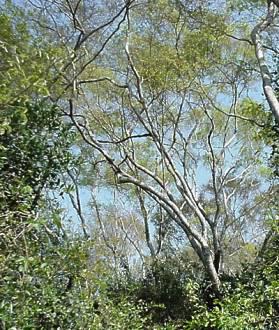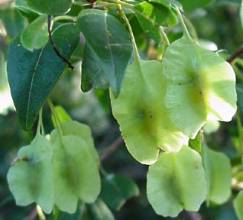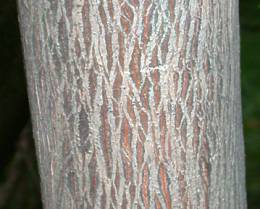Pteleopsis myrtifolia
Pteleopsis myrtifolia (M.A.Lawson) Engl. & Diels
Family: Combretaceae
Common names: stink-bushwillow (South Africa), two-winged stinkbush (Namibia), two-winged stink-bushwillow (Zimbabwe); stinkboswilg; musunganyemba (ChiManyika), musikanyemba (ChiNdau), umsunganyama (isiNdebele), amuyadi (Xironga), ngolozi (Chisena), fendaluzi (Chishona), mufundabalo (Chitonga), muandja (Xitshwa), n'wandla (Xitsonga), mwanda (Tshivenda), umwandla (isiZulu)
SA Tree No: 547
Introduction
Here we have a very attractive and under-appreciated tree, most often seen in one of the most unusual environments in South Africa, namely the sandveld of the coastal plain east of the Lebombo.

Description
Description
Briefly deciduous tree 3-10(- 20) m tall. Bark grey, smooth, adhering, with narrow fissures forming small ridges. Twigs hairy when very young, slender, dull, reddish brown and grey. Leaves opposite, simple; petioles to 10 mm long, densely hairy; blade 10-95 mm long, 6-35 mm wide, diamond-shaped; apex and base acute; surface dull, glabrous, sometimes glossy above; margins entire, sometimes wavy. Inflorescence an axillary, erect, loose head 45 mm long.
Calyx tubular, lobes 5, white. Petals 5, obovate or round, 1.5-2.5 mm long, 1-2 mm wide, white to yellow. Plants with bisexual and male flowers. Stamens 10; filaments free, 3.5-5.0 mm long. Fruit with 2 or 3 wings, 10-25 mm long, 5-17 mm in diameter, ellipsoid; rind buff.


This species may be confused in the field with Hymenocardia ulmoides, which has more rigid stems, alternate leaves and flatter fruit with a single wing.

Conservation Status
Status
The South African Red List (Raimondo et al. 2009) lists Pteleopsis as being of Least Concern. Considering its wide distribution and how common it often is where it occurs, this is an entirely reasonable assessment. However, it is very rare in Kenya, and Beentje (1994) notes only two records from there.
Distribution and habitat
Distribution description
This small tree is characteristic of woodlands and forests from northern Zululand through Mozambique, into the Nwambiya Sandveld of the Kruger National Park, northwards to Kenya and westwards to Angola. In Mkhuze Game Reserve some of the tourist roads pass through quite extensive pure stands of these trees. With this kind of distribution one would expect that it would only be a viable garden subject in areas of very sandy soil, high heat and low rainfall. However, actual experience suggests that this is not entirely true, as noted below.
Derivation of name and historical aspects
History
The genus name is derived from the Greek Ptelea = an elm tree and -opsis, a suffix indicating resemblance. The 2-winged fruits of our species resemble those of the common European Elm in shape and colour, but not in size. The specific epithet myrtifolia indicates that the small, diamond-shaped leaves resemble those of the garden myrtle, Myrtus communis.
This is the only one of about 10 species in the genus to occur in southern Africa; the record of P. anisoptera in some publications is based on a misidentification. That species is often difficult to distinguish from ours, and Exell (1970) gives a list of 11 characters, none conclusive, to look for when identifying tropical material. All the other species of the genus occur in tropical Africa. In many ways this genus is intermediate between Combretum and Terminalia, and shows similarities to both these genera.
Ecology
Ecology
In addition to the human uses noted below, the leaves of this tree are browsed by antelope, especially eland. The flowers are strongly scented and attract many insects, which in turn attract insect-eating birds. One report describes the scent as `like honey', but another describes it as rather unpleasant. Presumably, although insects appreciate the pointer to food, humans find the scent cloying when concentrated.
Uses
Use
My tree described below yielded material for experimental tests of antibacterial activity in the species. I am told (J.N. Eloff, pers. comm.) that although there is activity, there are other problems rendering this species unsuitable for medicinal use. However, in the right urban gardens it would be a useful decorative subject, and large, very mature specimens may also be useful shade trees.
The wood is hard, makes good furniture and can be used for construction. It is also used in Maputaland as a source of smoke for preserving food. The young stems are used in basketry.
Growing Pteleopsis myrtifolia
Grow
Many years ago Ian Garland gave me a seedling of this sandveld endemic which apparently requires heat and moisture. I planted it on the pavement (sidewalk) outside my home in Rooihuiskraal, Pretoria, in a quite clayey, sandstone-derived soil, in a small area which was only just frost-free. The only water it received (apart from the 700 mm-odd of rain in the area) was runoff from a nearby flowerbed. The tree thrived, and for all I know (having moved a long time ago) is still doing so. After 16 years it was between 3 and 4 m tall, but there are records from Zimbabwe National Botanical Garden, Harare, of trees growing to 8 or 10 metres in this time. Mr Garland gave Denzil Carr, the then doyen of Combretaceae-lovers, another seedling from the same batch, which he planted in a part of Sandton that cannot have been more than a degree or two colder than my garden. That one died in its first winter.
Carr (1988) notes that wild-collected seed is often 100% parasitised, and even with clean seed he seldom achieved more than 5% success in germinating new plants. He recommends soaking seed for 12 hours before planting (discarding any that float at this stage; those are parasitised) and then planting large numbers of seeds in the hope of obtaining a few small plants. This could be problematic, in that most potential parent trees in South Africa are in protected areas, and bringing seed in from elsewhere would require a massive amount of paperwork. Carr also notes that germination takes between 11 and 31 days, after which growers may lose a significant part of each batch when pricking out. However, after this, the young plants become much stronger and will grow quite fast in the open ground. Small numbers of trees may occasionally be available from specialist growers, but this species has not featured in any Botanical Society catalogues available to me.
Carr's and my experience both suggest that although established trees have very little resistance to cold, they are very resistant to drought. My tree showed no sign of any pests and diseases, and Carr also makes no mention of any such.
The weeping habit (at least of my tree) and usually small size suggest that in the right frost-free environment this tree would make an ideal dry-land substitute for several exotic, potentially invasive garden specimen trees, such as weeping willow (Salix babylonica) or the weeping form of white mulberry (Morus alba). The white flowers are an additional attraction for about one week in the year.
References
- Beentje, H.J. 1994. Kenya trees, shrubs and lianes. National Museums of Kenya, Nairobi.
- Carr, J.D. 1988. Combretaceae in southern Africa. Tree Society, Johannesburg.
- Coates Palgrave, M. 2002. Keith Coates Palgrave's Trees of southern Africa. Struik, Cape Town.
- Exell, A.W. 1970. Summary of the Combretaceae of Flora Zambesiaca. Kirkia 7: 159-252.
- Exell, A.W. 1978. Combretaceae in Flora zambesiaca 4: 100-183.
- Gillett, J.B. & McDonald, P.G. 1970. A numbered check-list of trees shrubs and noteworthy lianes indigenous to Kenya. Government Printer, Nairobi.
- Glen, H.F. 2004. SAPPI What's in a name? The meanings of the botanical names of trees. Jacana, Johannesburg.
- Palmer, E. & Pitman, N. 1972. Trees of southern Africa. Balkema, Cape Town.
- Raimondo, D., Von Staden, L., Foden, W., Victor, J.E., Helme, N.A., Turner, R.C., Kamundi, D.A. & Manyama, P.A. (eds) 2009. Red List of South African plants. Strelitzia 25. South African National Biodiversity Institute, Pretoria.
- Van Wyk, A.E., Van den Berg, E., Coates Palgrave, M. & Jordaan, M. 2011. Dictionary of names for southern African trees. Briza Academic, Pretoria.
- Van Wyk, A.E. (Braam) & Van Wyk, P. 1997. Field guide to trees of southern Africa. Struik, Cape Town.
Credits
Hugh .F. Glen
Kwazulu-Natal Herbarium
April 2011
Plant Attributes:
Plant Type: Shrub, Tree
SA Distribution: KwaZulu-Natal, Limpopo, Mpumalanga
Soil type: Sandy
Flowering season: Early Summer, Late Summer, Autumn
PH: Acid, Alkaline
Flower colour: White, Cream
Aspect: Full Sun
Gardening skill: Easy
Special Features:
Horticultural zones








Rate this article
Article well written and informative
Rate this plant
Is this an interesting plant?
Login to add your Comment
Back to topNot registered yet? Click here to register.